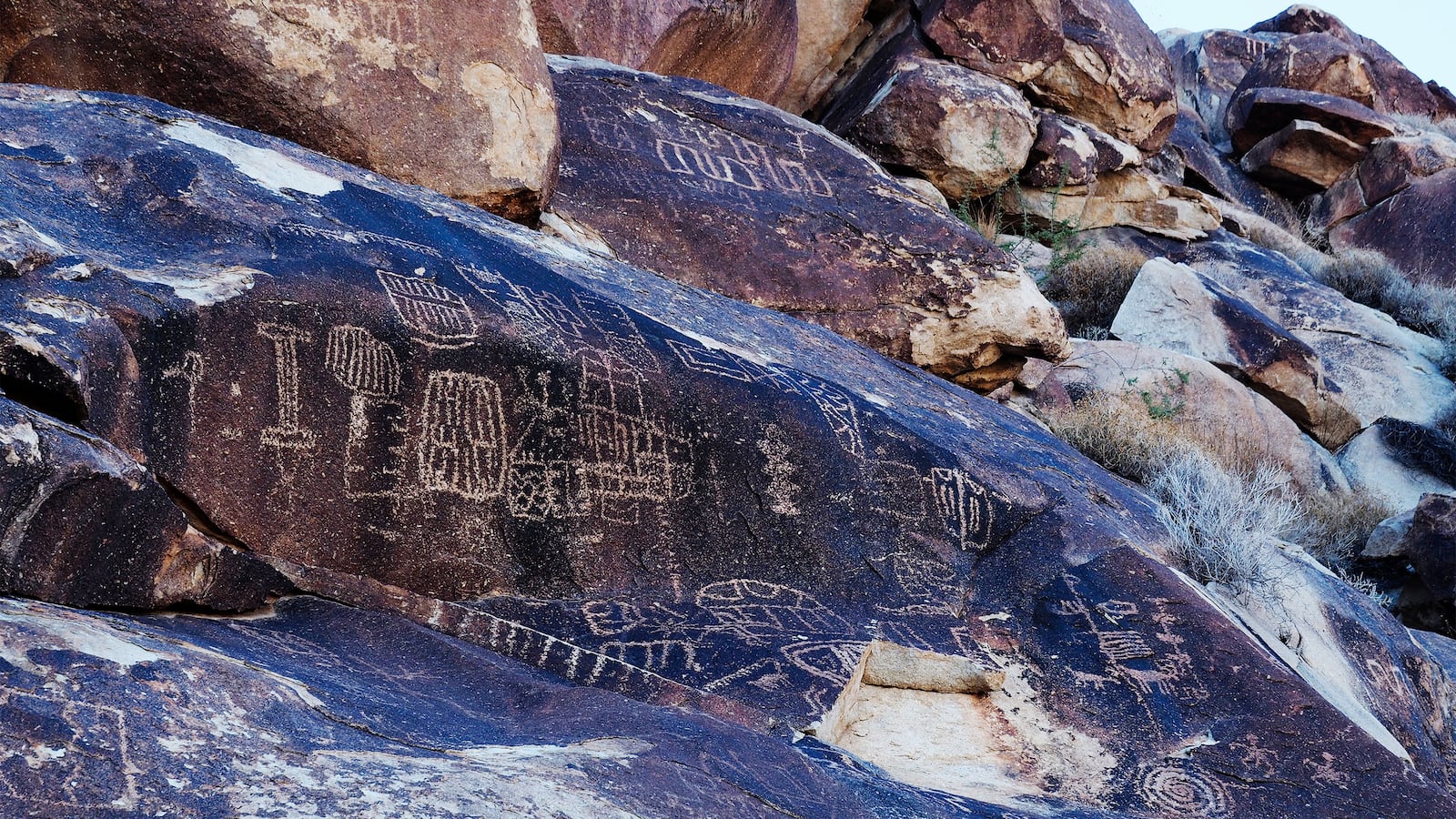In early April, Richard Gilbert, a 36-year-old climber, was climbing an easy route in Utah when he bolted into a well-known petroglyph called the “Sunshine Wall” created by the Fremont people, who lived in the region roughly a millennium ago.
In a since-deleted post, he said it was an accident and mistook the petroglyph for graffiti, writing, “honestly, to me, it looked like a group of high school kids got high AF and chiseled the rock.”
A few days after, Climbing magazine debunked his claim to ignorance, citing the fact that he captioned a photo of him on the route two weeks earlier as “Petroglyph of a man holding a spear!”
It was only a few weeks later that another petroglyph in Utah was defaced. The “Birthing Rock,” alternatively known as the “Birthing Scene Petroglyph,” near Moab involves images inscribed on the rock from over 1,000 years ago, including anthropomorphic figures, a woman giving birth (hence the name), bear tracks, bighorn sheep, and more.
Over all of this, vandals etched an ejaculating penis, and the words “white power”—once crossed out because they spelled “white” incorrectly on their first attempt.
In a statement, the Bureau of Land Management (BLM) responded to the Birthing Rock vandalism, writing they “strongly condemn vandalism of cultural resources and [are] working with professional conservators to remove the offensive graffiti.” They have also offered a $10,000 reward “for information leading to the arrest and conviction of the individual(s) responsible for the vandalism.”
While both events sent ripples through the climbing community, archaeologists, as well as the Indigenous communities in Utah, perhaps more shocking is the fact that they are in no way isolated incidents. In November, vandals defaced pictographs west of Bend, Oregon, and in April, vandals painted and scratched petroglyphs in Georgia beyond recognition.
According to Utah State Historic Preservation Office Public Archaeologist Elizabeth Hora, she’s had four projects like these come across her desk in the last four weeks alone.
Intentional or not, the one thing these events all have in common is this: they all took place on public lands. Tribes and archaeologists both agree that these lands need to be managed better, but the question remains: how best to do it?
On the internet, people were quick to chime in with potential solutions. Comments littering local news articles suggest positioning cameras above the sites, while others ideate reducing the size and scope of National Monuments in the region in the hopes of decreasing the amount of visitors—and thereby the likelihood of this happening. Others argued they should expand the National Monuments further in order to protect more land. But none of these suggestions truly get at the core of the issue, and none come without their own set of issues, drawbacks, and problems.
For example, Hora helped explain that extending the reach of National Monuments wouldn’t necessarily protect these petroglyphs further. “Even with a National Monument designation, it would still be BLM-managed, public land,” she said. This isn’t a problem per se, instead, it just alludes to the fact that changing the status of the land wouldn’t lead to an increase in funding or opportunities to better manage the land. She added that there are thousands of these sites spread out across Utah, making designation challenging as well. As for trail cameras, they’ve tried it—but they were often and easily damaged.
The old way of protecting and preserving these sites, according to Hora, was largely avoidance. “We knew where the sites were, but we just didn’t tell people,” she told The Daily Beast. “Before COVID, we were ringing our hands about Instagram, because people were going further and further into the backcountry to try to get pictures further out from civilization.”
In efforts to direct travelers away from these sites, archaeologists had worked to “harden” these areas, making them increasingly difficult to access by putting trails that led near the sites, but not to the sites.
With avoidance becoming less and less of a possibility as outdoor usage on public lands continues to grow, Hora is placing future bets on education. “We haven’t told people what to do when they go out and find these resources or even how to identify them for over a generation,” she told The Daily Beast.
In an effort to counteract the recent bouts of vandalism, Hora has launched the Stop Archaeological Vandalism campaign, which aims to educate people on how to behave in these sites, and to promote awareness of the importance of these cultural resources.
However, while tribes recognize that education around how to behave in these places is important, many argue that this type of vandalism and disregard for the lands is a symptom of a larger issue that they’d like to address.
Patrick Gonzalez-Rogers, the executive director of the Bears Ears Intertribal Coalition, which represents the Hopi, Navajo, Ute, Ute Mountain, and Zuni tribes, told the Daily Beast, “If this was Notre Dame, there would be an incredible outcry, and so we should have the same sense of urgency, and the deference and profundity to protecting this.”
“This conversation is way deeper than someone damaging a rock panel,” Angelo Baca, the cultural resources coordinator for Dine Bikeyah, a Native American-led grassroots nonprofit working to promote healing of people and the earth through conservation of cultural lands, told the Daily Beast.
“If even in the remotest of places, people are writing things like ‘white power,’ there is clearly a larger problem going on,” he points out. While he argues he’s not surprised, after growing up in San Juan, which he referred to as “one of the most racist counties in the U.S.,” he hopes “these events can lead to addressing the actual, systemic issue, and not just the symptoms.”
While it may feel easy or perhaps intuitive to look upon these petroglyphs as historical artifacts, remnants of the past in need of preservation, Baca explained that they are in fact, the opposite. Instead, he argues the recent events and the conversations we have around them can perhaps help us rethink and shift paradigms about how we think about lands and the indigenous communities who inhabit them.
“When we talk about these places, these [rock] panels, we're not talking about a cultural, historical resource—we’re talking about a relative, a living relative, someone we still have a connection to,” he said. “We see it as a part of us. When you destroy that rock panel, you do that to us. You destroy us.”
This was especially prevalent for the Birthing Rock, which Baca says is another “direct attack on Indigenous women.” He says, “They don’t see them or us, as full human beings. They see [Indigenous women] as someone who can be lost, damaged, objectified.”
For Baca, then, the damaging of the petroglyph isn’t simply an erasure of history, but instead, a disrespect for his past, present, and future culture and sense of self.
This is why Baca wouldn’t like to see these places solely preserved, and he wouldn’t like to see the focus lie solely on education in regards to how to behave in these places either. Instead, Baca and Gonzalez-Rogers both insist the conversation needs to shift towards a deeper understanding of their peoples and their lands, with their people at the forefront, leading those conversations.
“It’s not just about preserving or maintaining, it’s about living and growing” he said, suggesting that denoting this land as historical or ancient doesn’t do it justice, since tribes still derive meaning and use from it today. In fact, by believing these are “ancient relics,” he argues, we are continuing to colonize and effectively erase the people who currently live in the region.
Ultimately, Baca hopes that “the preservation aspect of these histories and living cultures comes as a natural byproduct of people wanting to do what is actually good for the Indigenous community so it can thrive and continue to exist.”
“That, at the end of the day, is the answer to the riddle. It’s not about forcing anyone to do anything.”

